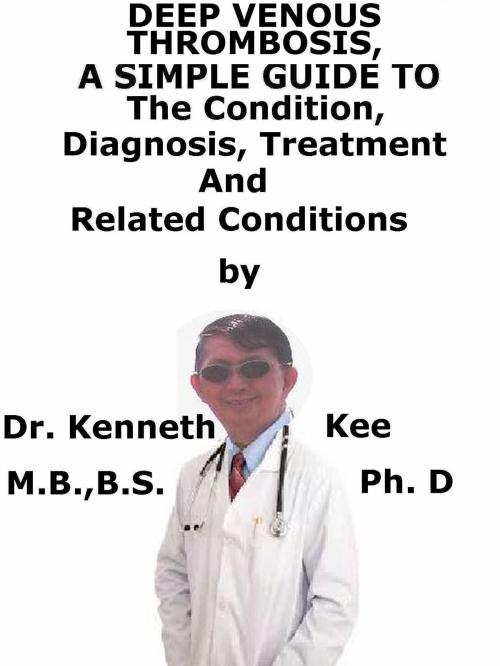Deep Venous Thrombosis, A Simple Guide To The Condition, Diagnosis, Treatment And Related Conditions
Nonfiction, Health & Well Being, Medical, Surgery, Vascular, Health, Ailments & Diseases, Heart| Author: | Kenneth Kee | ISBN: | 9781370034406 |
| Publisher: | Kenneth Kee | Publication: | September 8, 2017 |
| Imprint: | Smashwords Edition | Language: | English |
| Author: | Kenneth Kee |
| ISBN: | 9781370034406 |
| Publisher: | Kenneth Kee |
| Publication: | September 8, 2017 |
| Imprint: | Smashwords Edition |
| Language: | English |
Deep Venous Thrombosis (DVT) is a blood clot (thrombus) in a deep vein (venous) leading to the heart, normally in the legs.
The blood clot may either block the vein completely or partially.
Deep venous thrombosis is a blood clot that forms in a vein deep inside a part of the body.
DVT normally happens in a deep leg vein, a larger vein that extends through the muscles of the calf and the thigh.
It can cause pain and swelling in the leg and may result in complications such as pulmonary embolism.
This is when a piece of blood clot breaks off into the bloodstream and obstructs one of the blood vessels in the lungs.
DVT and pulmonary embolism together are known as venous thromboembolism (VTE).
Clots can form in superficial veins (called superficial thrombophlebitis or phlebitis) and in deep veins because of poor blood flow or stasis.
Blood clots in deep veins (Deep Venous Thrombosis) need immediate medical care.
These blood clots are dangerous because they can break loose and then travel through the bloodstream to the lungs causing a pulmonary embolism
Deaths resulting from complications of DVT are not something new.
Blood clots most often form in the calf and thigh veins, and less often in the arm or pelvic veins.
DVT does not cause heart attack or stroke.
3 major factors have a part in the development of DVT:
1. Venous stasis
2. Damage of the vein
3. Higher coagulability
In some cases of DVT there may be no symptoms.
DVT can cause:
a. Pain, swelling and tenderness in one of the legs
b. Warm skin in the area of the clot
c. Heavy ache in the leg
d. Redness of the skin particularly at the back of the leg below the knee
DVT normally affects one leg
Diagnosis:
a. The above symptoms alone and a physical exam.
The exam may show a red, swollen, or tender leg.
b. D-dimer test
A specialized blood test called the D-dimer test is used to detect pieces of blood clot that have been broken down and are loose in the bloodstream.
Treatment of DVT
a. Prevent pulmonary embolism (PE),
b. Reduce morbidity,
c. Prevent or minimize the risk of developing the post-thrombotic syndrome (PTS).
An anticoagulant will keep more clots from forming or old ones from getting bigger.
These drugs do not dissolve clots already there.
That is accomplished by the body’s natural blood system.
Other anticoagulation drugs have subsequently been added to the treatment over the years such as vitamin K antagonists and low-molecular-weight heparin (LMWH).
IV Heparin is normally prescribed first because it works immediately to prevent further clotting.
After this treatment the patient may also need to take oral warfarin to prevent another blood clot forming.
Heparin is available in two different forms:
1. Standard (unfractioned) heparin
2. Low Molecular Weight Heparin (LMWH)
LMWH is normally given as a subcutaneous injection
LMWH works differently from standard heparin.
It contains small molecules which mean its effects are more reliable and the patient will not have to stay in hospital and be monitored.
Both standard and LMWH can cause side effects including:
a. A skin rash and other allergic reactions
b. Bleeding
c. Weakening of the bones
The instant symptoms of DVT often recover with anticoagulation alone.
The reason for intervention is often reduction of the 75% long-term risk of PTS.
Lifetime anticoagulation therapy may be advised:
1. If DVT recurs,
2. If a chronic hyper-coagulability is identified
3. If PE is life threatening
Surgery
In rare cases surgery may be needed if medicines do not work.
Surgery may involve:
1. Placing a vena cava filter
2. Removing a large blood clot from the vein
Compression stockings and ambulation help prevent calf pain and swelling
TABLE OF CONTENT
Introduction
Chapter 1 Deep Venous Thrombosis
Chapter 2 Causes
Chapter 3 Symptoms
Chapter 4 Diagnosis
Chapter 5 Treatment
Chapter 6 Prognosis
Chapter 7 Varicose Veins
Chapter 8 Pulmonary Embolism
Epilogue
Deep Venous Thrombosis (DVT) is a blood clot (thrombus) in a deep vein (venous) leading to the heart, normally in the legs.
The blood clot may either block the vein completely or partially.
Deep venous thrombosis is a blood clot that forms in a vein deep inside a part of the body.
DVT normally happens in a deep leg vein, a larger vein that extends through the muscles of the calf and the thigh.
It can cause pain and swelling in the leg and may result in complications such as pulmonary embolism.
This is when a piece of blood clot breaks off into the bloodstream and obstructs one of the blood vessels in the lungs.
DVT and pulmonary embolism together are known as venous thromboembolism (VTE).
Clots can form in superficial veins (called superficial thrombophlebitis or phlebitis) and in deep veins because of poor blood flow or stasis.
Blood clots in deep veins (Deep Venous Thrombosis) need immediate medical care.
These blood clots are dangerous because they can break loose and then travel through the bloodstream to the lungs causing a pulmonary embolism
Deaths resulting from complications of DVT are not something new.
Blood clots most often form in the calf and thigh veins, and less often in the arm or pelvic veins.
DVT does not cause heart attack or stroke.
3 major factors have a part in the development of DVT:
1. Venous stasis
2. Damage of the vein
3. Higher coagulability
In some cases of DVT there may be no symptoms.
DVT can cause:
a. Pain, swelling and tenderness in one of the legs
b. Warm skin in the area of the clot
c. Heavy ache in the leg
d. Redness of the skin particularly at the back of the leg below the knee
DVT normally affects one leg
Diagnosis:
a. The above symptoms alone and a physical exam.
The exam may show a red, swollen, or tender leg.
b. D-dimer test
A specialized blood test called the D-dimer test is used to detect pieces of blood clot that have been broken down and are loose in the bloodstream.
Treatment of DVT
a. Prevent pulmonary embolism (PE),
b. Reduce morbidity,
c. Prevent or minimize the risk of developing the post-thrombotic syndrome (PTS).
An anticoagulant will keep more clots from forming or old ones from getting bigger.
These drugs do not dissolve clots already there.
That is accomplished by the body’s natural blood system.
Other anticoagulation drugs have subsequently been added to the treatment over the years such as vitamin K antagonists and low-molecular-weight heparin (LMWH).
IV Heparin is normally prescribed first because it works immediately to prevent further clotting.
After this treatment the patient may also need to take oral warfarin to prevent another blood clot forming.
Heparin is available in two different forms:
1. Standard (unfractioned) heparin
2. Low Molecular Weight Heparin (LMWH)
LMWH is normally given as a subcutaneous injection
LMWH works differently from standard heparin.
It contains small molecules which mean its effects are more reliable and the patient will not have to stay in hospital and be monitored.
Both standard and LMWH can cause side effects including:
a. A skin rash and other allergic reactions
b. Bleeding
c. Weakening of the bones
The instant symptoms of DVT often recover with anticoagulation alone.
The reason for intervention is often reduction of the 75% long-term risk of PTS.
Lifetime anticoagulation therapy may be advised:
1. If DVT recurs,
2. If a chronic hyper-coagulability is identified
3. If PE is life threatening
Surgery
In rare cases surgery may be needed if medicines do not work.
Surgery may involve:
1. Placing a vena cava filter
2. Removing a large blood clot from the vein
Compression stockings and ambulation help prevent calf pain and swelling
TABLE OF CONTENT
Introduction
Chapter 1 Deep Venous Thrombosis
Chapter 2 Causes
Chapter 3 Symptoms
Chapter 4 Diagnosis
Chapter 5 Treatment
Chapter 6 Prognosis
Chapter 7 Varicose Veins
Chapter 8 Pulmonary Embolism
Epilogue















